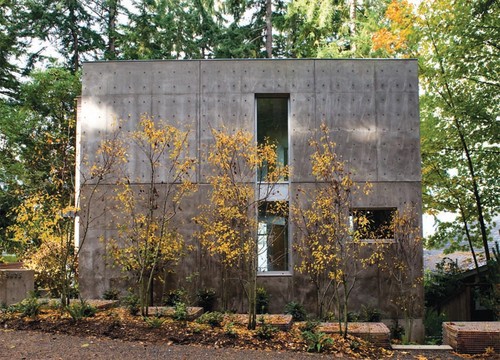Concrete is one of the most used construction materials. If it is mixed with different other materials, the result will be fiber reinforced concrete.

Photo by Coates Design Architects Seattle – More exterior home photos
These materials are added when concrete is in a liquid state. Their role is to make concrete even stronger than it is and more resistant to large temperature differences. It is well known that concrete is one of the most resistant materials in compression but has a low resistance to tensile forces. Therefore, concrete is reinforced with these fibers that are quite strong in tension.
There are generally, four fiber reinforced concrete types:
- 1) Steel Fiber Reinforced Concrete
- 2) Synthetic Fiber Reinforced Concrete
- 3) Glass Fiber Reinforced Concrete
- 4) Natural Fiber Reinforced Concrete
1| STEEL FIBER REINFORCED CONCRETE
Steel (welded wire mesh) fiber reinforced concrete is practically, an easier and cheaper alternative to rebar reinforced concrete that use steel bars for reinforcement. These steel bars are laid in the concrete mass when it is still wet. Of course, this is a lot of work but the result is a very strong concrete.
Steel fiber reinforced concrete is the result of replacing steel bars with steel wires. These thin steel wires are mixed in the concrete composition in the same time with the Portland cement. Your concrete will have an outstanding structural strength and will be more protected against extreme cold. Steel fibers increase also, the bending of the concrete, its ductility and they have a great impact resistance and crack control. However, steel fiber is very often used mixed with steel rebar in the concrete composition.
2| SYNTHETIC FIBER REINFORCED CONCRETE
Synthetic fiber reinforced concrete consists of concrete mixed with nylon and plastic fibers. They improve quite significantly the concrete strength. The use of steel fiber reinforced concrete in residential building construction has been on the decline for the last decade. More contractors switch their preferences to synthetic fiber reinforced concrete, which quickly became a substitute for welded wire mesh reinforced concrete in residential building slabs. They do not expand or contract as steel fiber to temperature changes. That prevents synthetic fiber reinforced concrete to crack. Obviously, synthetic fibers are not so strong as steel fibers but they improve a lot the cement pumpability and will keep the concrete to stick in the pump pipes.
3| GLASS FIBER REINFORCED CONCRETE
Glass fiber reinforced concrete is another type of reinforced concrete especially used as façade panels for residential and commercial buildings. This type of reinforced concrete is made by adding glass fibers in the concrete mass. These fibers are similar with the fibers from fiberglass insulation, therefore these fiberglass will make the concrete much stronger and plus will insulate it. More than that, steel fiber interferes with radio signals while glass fiber does not.
4| NATURAL FIBER REINFORCED CONCRETE
Although, over the years many kinds of fibers have been used as reinforcement such as hair, hay, coconut, plantain (banana), sugarcane, sisal, palm, etc , until recently too little scientific effort has been given in the development of a technology capable of using these natural fibers on an industrial scale. However, naturally available fibers that can be used as reinforcement create a low-cost reinforced concrete, which is good when you need to save money, but a natural fiber reinforced concrete has several obvious disadvantages such as:
a) Natural fibers can rot even when they are in the concrete mass.
b) If they are too much used they can make the concrete weaker
A Smart Solution for Every Surface – Concrete Concrete (howtobuildahouseblog.com)


